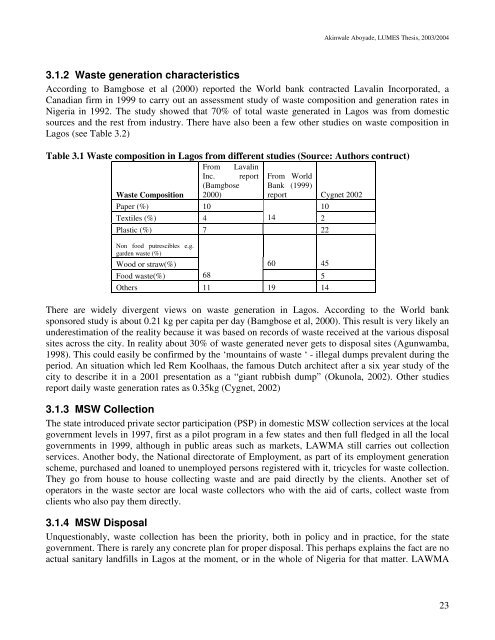Wale Aboyade's thesis - lumes
Wale Aboyade's thesis - lumes
Wale Aboyade's thesis - lumes
You also want an ePaper? Increase the reach of your titles
YUMPU automatically turns print PDFs into web optimized ePapers that Google loves.
Akinwale Aboyade, LUMES Thesis, 2003/2004<br />
3.1.2 Waste generation characteristics<br />
According to Bamgbose et al (2000) reported the World bank contracted Lavalin Incorporated, a<br />
Canadian firm in 1999 to carry out an assessment study of waste composition and generation rates in<br />
Nigeria in 1992. The study showed that 70% of total waste generated in Lagos was from domestic<br />
sources and the rest from industry. There have also been a few other studies on waste composition in<br />
Lagos (see Table 3.2)<br />
Table 3.1 Waste composition in Lagos from different studies (Source: Authors contruct)<br />
From Lavalin<br />
Inc. report From World<br />
Waste Composition<br />
(Bamgbose<br />
2000)<br />
Bank (1999)<br />
report Cygnet 2002<br />
Paper (%) 10 10<br />
Textiles (%) 4 14 2<br />
Plastic (%) 7 22<br />
Non food putrescibles e.g.<br />
garden waste (%)<br />
Wood or straw(%) 60 45<br />
Food waste(%) 68 5<br />
Others 11 19 14<br />
There are widely divergent views on waste generation in Lagos. According to the World bank<br />
sponsored study is about 0.21 kg per capita per day (Bamgbose et al, 2000). This result is very likely an<br />
underestimation of the reality because it was based on records of waste received at the various disposal<br />
sites across the city. In reality about 30% of waste generated never gets to disposal sites (Agunwamba,<br />
1998). This could easily be confirmed by the ‘mountains of waste ‘ - illegal dumps prevalent during the<br />
period. An situation which led Rem Koolhaas, the famous Dutch architect after a six year study of the<br />
city to describe it in a 2001 presentation as a “giant rubbish dump” (Okunola, 2002). Other studies<br />
report daily waste generation rates as 0.35kg (Cygnet, 2002)<br />
3.1.3 MSW Collection<br />
The state introduced private sector participation (PSP) in domestic MSW collection services at the local<br />
government levels in 1997, first as a pilot program in a few states and then full fledged in all the local<br />
governments in 1999, although in public areas such as markets, LAWMA still carries out collection<br />
services. Another body, the National directorate of Employment, as part of its employment generation<br />
scheme, purchased and loaned to unemployed persons registered with it, tricycles for waste collection.<br />
They go from house to house collecting waste and are paid directly by the clients. Another set of<br />
operators in the waste sector are local waste collectors who with the aid of carts, collect waste from<br />
clients who also pay them directly.<br />
3.1.4 MSW Disposal<br />
Unquestionably, waste collection has been the priority, both in policy and in practice, for the state<br />
government. There is rarely any concrete plan for proper disposal. This perhaps explains the fact are no<br />
actual sanitary landfills in Lagos at the moment, or in the whole of Nigeria for that matter. LAWMA<br />
23

















